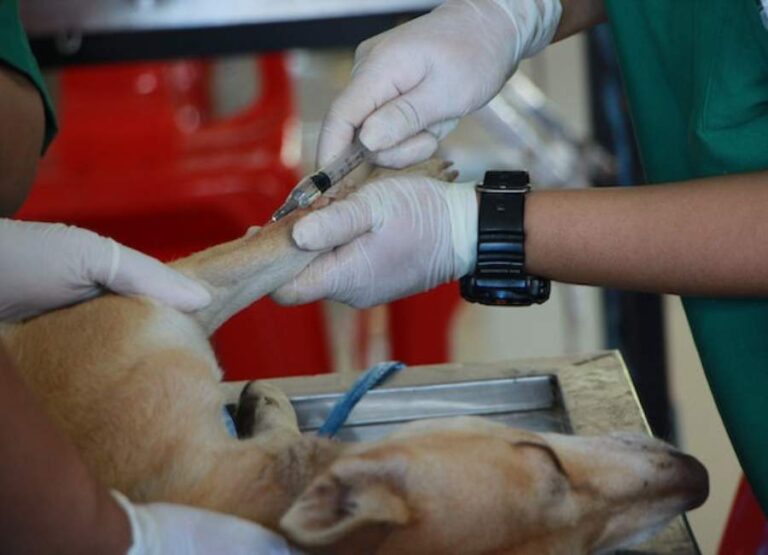11 Potential Signs of Trauma in Dogs

Today, let’s dive into a crucial topic that deserves our attention: signs of trauma in dogs.
Our canine companions are incredibly resilient, but they can experience emotional wounds just like we do.
So, join me as we explore the telltale signs that our beloved dogs may be carrying unseen burdens.
Signs of Trauma in Dogs
Signs of trauma in dogs include chronic anxiety, hypervigilance, avoidance of certain people, places, or situations, sleep disturbances, fear of being alone, decreased interest in a favorite activity, aggression, hiding, shaking or trembling, and unwarranted stress reactions.
Let’s break it down further…
Here are some of the most common signs of trauma in dogs:
1. Hiding or Clinginess
When a dog experiences trauma, they may exhibit hiding or clinginess as a coping mechanism.
Hiding can be a way for the dog to seek a sense of safety and security, especially if they have encountered a frightening or distressing event.
On the other hand, clinginess may manifest as the dog constantly seeking physical closeness or reassurance from their human companions.
This behavior can be a clear indicator that the dog is feeling anxious or distressed and is seeking comfort and support.
2. Behavioral Changes
Behavioral changes in dogs can be quite varied and may include increased fearfulness, excessive barking, pacing, or destructive behavior.
Trauma can lead to a heightened state of anxiety, which may cause the dog to react more strongly to stimuli that previously did not bother them.
For example, a normally friendly dog may become more hesitant or even aggressive towards strangers or other animals.
Additionally, they may exhibit avoidance behaviors such as trying to escape or hide when confronted with triggers that remind them of the traumatic event.
Learn more about head trauma in dogs.
3. Appetite Alterations
Appetite alterations can be a significant indication of a dog’s emotional state.
Trauma can lead to a loss of appetite or conversely, an increase in eating as a form of comfort-seeking behavior.
A traumatized dog may lose interest in food and treats, which can lead to weight loss and other health issues.
Conversely, some dogs may seek solace in food as a way to cope with their emotional distress, resulting in excessive eating or weight gain.
4. Hypervigilance
When a dog is hypervigilant, it means they are constantly on high alert, scanning their environment for potential threats.
This can be a common sign of trauma in dogs. Signs of hypervigilance in dogs may include excessive barking, restlessness, and being easily startled.
It’s important to note that hypervigilance can be a symptom of post-traumatic stress disorder (PTSD) in dogs, just as it is in humans.
5. Avoidance of Certain Places or People
Dogs that have experienced trauma may exhibit avoidance behavior towards specific places or people associated with the traumatic event.
This can manifest as reluctance or refusal to enter certain rooms, go for walks in particular areas, or interact with specific individuals.
Avoidance behavior is a common response to trauma in dogs and can be an indicator of underlying distress.
6. Changes in Sleep Patterns

Trauma can also lead to changes in a dog’s sleep patterns. Dogs may experience difficulty falling asleep, frequently waking during the night, or even exhibit signs of insomnia.
Conversely, some dogs may also display an increased need for sleep as a coping mechanism for dealing with the effects of trauma.
These changes in sleep patterns can be indicative of the emotional impact of trauma on dogs.
7. Unexplained Aggression
When a dog displays unexplained aggression, it can be a sign of trauma.
This behavior can be concerning and may indicate that the dog is experiencing distress or discomfort.
Signs of unprovoked aggression, especially towards people or other animals, should be taken seriously and addressed with care.
According to a case shared by a dog owner, the dog exhibited unprovoked aggression and unpredictable attacks, which are common signs of trauma.
8. Excessive Licking or Chewing
Excessive licking or chewing can also be a sign of trauma in dogs. This behavior may be a coping mechanism for stress or anxiety.
Dogs may excessively lick or chew on themselves as a way to self-soothe when they are feeling distressed.
It’s important to pay attention to changes in a dog’s grooming habits, as excessive licking or chewing can indicate underlying emotional or physical issues.
9. Loss of Interest in Play
A loss of interest in play can be another indicator of trauma in dogs. Dogs that have experienced trauma may exhibit a lack of enthusiasm for activities they once enjoyed.
This change in behavior can be a result of emotional distress or discomfort.
It’s essential to observe and understand a dog’s usual behavior and recognize any significant shifts, such as a sudden disinterest in play, as potential signs of trauma.
10. Shaking or Trembling
One common sign of trauma in dogs is shaking or trembling. This can be a physical manifestation of fear, anxiety, or distress.
It’s important to pay attention to the context in which the shaking or trembling occurs, as it can provide valuable insights into the dog’s emotional state.
For example, if a dog starts shaking or trembling in response to loud noises or unfamiliar environments, it could be a sign of fear or anxiety.
11. Changes in Body Language
Dogs often communicate their emotional state through body language.
Changes in body language, such as cowering, tucking the tail between the legs, or avoiding eye contact, can indicate that a dog is experiencing trauma.
These behaviors may be accompanied by other signs of distress, such as panting, pacing, or seeking isolation.
It’s essential to observe these changes in conjunction with the dog’s overall behavior to better understand their emotional well-being.
By paying attention to these signs, pet owners and caregivers can better support dogs who may be experiencing trauma.
Learn more about eye trauma in dogs.
How to Help a Traumatized Dog

From my personal experience living with dogs, helping a traumatized dog can be a challenging but incredibly rewarding experience.
First off, create a safe and calm environment for the dog by providing a comfortable space to retreat to when feeling overwhelmed.
Then, establish a routine to help the dog feel secure and predict what’s coming next.
Most importantly, use positive reinforcement techniques to build trust and confidence, rewarding good behavior with treats, toys, or praise.
It’s also important to give the dog time and space to adjust, allowing them to approach new people and situations at their own pace.
Always try to engage the dog in gentle, low-pressure activities like short walks or interactive play can help the dog build positive associations.
If things are not going to plan, consider seeking professional help from a certified dog behaviorist or trainer to develop a personalized plan for the dog’s recovery.
Finally, be patient, understanding, and consistent in your approach, as healing from trauma takes time and dedication.
Related Questions
What are the signs that a dog may be experiencing trauma?
When a dog is experiencing trauma, there are several signs to look out for. These may include excessive barking or howling, aggression, withdrawal, changes in appetite, excessive panting, trembling, or destructive behavior. Additionally, a traumatized dog may exhibit avoidance of certain people or places, and may also display signs of depression or anxiety.
How can I help a traumatized dog?
If you suspect that your dog is experiencing trauma, it’s important to provide a safe and comforting environment. Establishing a routine and maintaining a calm and predictable atmosphere can be beneficial. Additionally, providing plenty of exercise, mental stimulation, and positive reinforcement can aid in the recovery process. Seeking professional help from a veterinarian or a certified dog behaviorist is also recommended to develop a tailored plan for your dog’s specific needs.
Can trauma in dogs lead to long-term behavioral issues?
Yes, trauma in dogs can lead to long-term behavioral issues if not addressed appropriately. Untreated trauma can result in ongoing anxiety, fear, and aggression. It may also lead to phobias, separation anxiety, and other behavioral problems. It’s crucial to address trauma in dogs promptly to prevent long-term behavioral issues.
What are the common causes of trauma in dogs?
Trauma in dogs can be caused by various factors such as abuse, neglect, sudden loud noises, accidents, changes in the environment, or exposure to frightening or distressing situations. Additionally, traumatic experiences like being attacked by another animal or being involved in a car accident can also lead to trauma in dogs.
How can I differentiate between normal dog behavior and signs of trauma?
Differentiating between normal dog behavior and signs of trauma can be challenging. However, persistent and extreme behaviors such as excessive fear, aggression, or withdrawal, especially when they are out of character for the dog, may indicate trauma. It’s important to observe your dog’s behavior closely and seek professional guidance if you suspect trauma.
Can trauma in dogs be effectively treated?
Yes, trauma in dogs can be effectively treated with the right approach. Professional intervention, such as working with a certified dog behaviorist or a veterinarian, can provide tailored strategies to help the dog overcome trauma. Treatment may involve behavior modification techniques, desensitization, counter-conditioning, and in some cases, medication. With patience, understanding, and consistent support, many dogs can recover from trauma and lead fulfilling lives.
Conclusion
In conclusion, recognizing signs of trauma in dogs is crucial for their well-being. By paying attention to subtle changes in behavior, such as increased anxiety or aggression, we can provide the necessary support and care. Remember, a compassionate and understanding approach goes a long way in helping our furry friends heal and thrive.



![Why Does My Beagle Shake [8 Reasons & Tips] Why Does My Beagle Shake](https://petcreeks.com/wp-content/uploads/2021/04/dog-5206460_640.jpg)


![Dog Not Eating But Throwing Up [9 Reasons & Tips] Dog Not Eating But Throwing Up](https://petcreeks.com/wp-content/uploads/2023/04/Dog-Not-Eating-But-Throwing-Up-768x555.jpg)